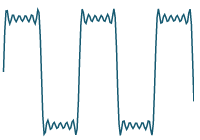Fourier Series - Introduction
Fourier series are used in the analysis of periodic functions.

A periodic square wave
Many of the phenomena studied in engineering and science are periodic in nature eg. the current and voltage in an alternating current circuit. These periodic functions can be analysed into their constituent components (fundamentals and harmonics) by a process called Fourier analysis.
We are aiming to find an approximation using trigonometric functions for various square, saw tooth, etc waveforms that occur in electronics. We do this by adding more and more trigonometric functions together. The sum of these special trigonometric functions is called the Fourier Series.
Jean Fourier

Jean Baptiste Joseph
Fourier (1768 - 1830).
Fourier was a French mathematician, who was taught by Lagrange and Laplace.
He almost died on the guillotine in the French Revolution. Fourier was a buddy of Napoleon and worked as scientific adviser for Napoleon's army.
He worked on theories of heat and expansions of functions as trigonometric series... but these were controversial at the time. Like many scientists, he had to battle to get his ideas accepted.
In this Chapter
Helpful Revision - all the trigonometry, functions, summation notation and integrals that you will need for this Fourier Series chapter.
1. Overview of Fourier Series - the definition of Fourier Series and how it is an example of a trigonometric infinite series
2. Full Range Fourier Series - various forms of the Fourier Series
3. Fourier Series of Even and Odd Functions - this section makes your life easier, because it significantly cuts down the work
4. Fourier Series of Half Range Functions - this section also makes life easier
5. Harmonic Analysis - this is an interesting application of Fourier Series
6. Line Spectrum - important in the analysis of any waveforms. Also has implications in music
7. Fast Fourier Transform - how to create CDs and how the human ear works, all with Fourier Series
We begin the chapter with Helpful Revision »